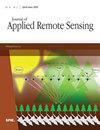Examining the impact of hydro-geomorphological features in satellite river width-based discharge estimations
IF 1.4
4区 地球科学
Q4 ENVIRONMENTAL SCIENCES
引用次数: 0
Abstract
We investigate the reliability of satellite river width (SRW) measurements to estimate the river discharge and its sensitivity to various hydro-geomorphological features. The study encompasses SRW extents at 141 in-situ hydrological observation stations, across seven tropical basins in India, with a mean annual discharge ranging from 2351 m3/s to less than 1 m3/s. Integrating optical (Sentinel-2, Landsat) and synthetic-aperture radar (SAR; Sentinel-1) data in the Google Earth Engine (GEE), 63,885 images are processed in the GEE to generate a dense time series of the SRW. Results demonstrate a good correlation (>0.50) between the SRW and in-situ discharge at 61 stations, primarily in the Godavari and Mahanadi basins. Furthermore, SRW-based rating curves exhibit reliable predictive capabilities at 44 stations, highlighting the potential to develop SRW rating curves in sparsely gauged basins. Investigations on the possible impact of different hydro-geomorphological features on the performance of the SRW to estimate the river discharge revealed optimal conditions in river reaches at lower elevations with substantial temporal variations in the discharge and associated variation in the river width along with a history of maximum water spread. Consequently, the Surface Water and Ocean Topography satellite’s river networks in the region are classified based on these findings, with 3567 out of 6132 river reaches identified as suitable for reliable SRW-based discharge estimation.考察水文地质特征对基于卫星河宽的排水量估算的影响
我们研究了卫星河宽(SRW)测量估算河流排放量的可靠性及其对各种水文地质特征的敏感性。这项研究涵盖了印度 7 个热带流域 141 个现场水文观测站的 SRW 范围,年平均排水量从 2351 立方米/秒到小于 1 立方米/秒不等。在谷歌地球引擎(GEE)中整合了光学(哨兵-2、大地遥感卫星)和合成孔径雷达(SAR;哨兵-1)数据,在 GEE 中处理了 63,885 幅图像,生成了 SRW 的密集时间序列。结果表明,SRW 与 61 个站点(主要位于戈达瓦里流域和马哈纳迪流域)的原位排水量之间存在良好的相关性(大于 0.50)。此外,基于 SRW 的定级曲线在 44 个站点显示出可靠的预测能力,突出表明了在测 量稀少的流域开发 SRW 定级曲线的潜力。关于不同水文地质特征对 SRW 估测河流排水量的性能可能产生的影响的调查显示,在海拔较低的河段,排水量和相关的河宽变化以及最大水量扩散的历史都有很大的时间变化,这些河段的条件最佳。因此,根据这些发现对地表水和海洋地形卫星在该区域的河网进行了分类,在6132条河段中有3567条河段被确定为适合进行可靠的基于SRW的排泄量估算。
本文章由计算机程序翻译,如有差异,请以英文原文为准。
求助全文
约1分钟内获得全文
求助全文
来源期刊

Journal of Applied Remote Sensing
环境科学-成像科学与照相技术
CiteScore
3.40
自引率
11.80%
发文量
194
审稿时长
3 months
期刊介绍:
The Journal of Applied Remote Sensing is a peer-reviewed journal that optimizes the communication of concepts, information, and progress among the remote sensing community.
 求助内容:
求助内容: 应助结果提醒方式:
应助结果提醒方式:


